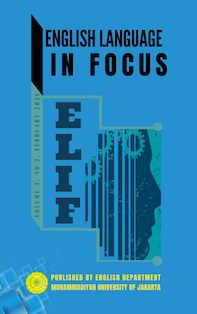Google Classroom-Assisted Mobile in Language Learning for Students of Primary School Teacher Education
DOI:
https://doi.org/10.24853/elif.3.2.135-142Keywords:
Google Classroom, Mobile Assisted Language Learning, the Primary School Teacher EducationAbstract
Language learning activities are required for all students of the Faculty of Education at Universitas Muhammadiyah Jakarta. So far, the learning process in the classroom has been carried out conventionally. Lecturers come to class, deliver lessons, and assign homework to students. Teaching and learning activities are routine activities that frequently bore students and make them uninterested in taking the class. Students' boredom requires an alternative learning process that does not adhere to conventional concepts but has adopted novelty by using free applications that can be downloaded on each student's smartphone. Google Classroom, an online learning system that allows lecturers and students to carry out the learning process wherever and whenever they want, is one solution that can be provided. It is expected that students' English learning will improve as a result of their use of Google Classroom. As a result, it offers a variety of new learning opportunities and can accommodate students' preferences. The use of Google Classrooms is also consistent with the rapid development of technology, which is supported by the slogan of the Industrial Revolution era 4.0. It has also touched the 5.0 era, which leads to the use of technology products that can be used in the classroom learning process and supports the new minister of education's policies regarding freedom of learning.References
Abusa’aleek, A. O. (2014). A Review of Emerging Technologies: Mobile Assisted Language Learning (MALL). Asian Journal of Education and E-Learning, 2(6), 469–475. Retrieved from http://www.ajouronline.com/
Foomani, E. M., & Hedayati, M. (2016). A Seamless Learning Design for Mobile Assisted Language Learning: An Iranian Context. English Language Teaching, 9(5), 206–213. Retrieved from https://eric.ed.gov/?id=EJ1099606
Gour, S. (2018). Integration of Technology with Google Classroom in Higher Education. International Journal of Scientific Research in Computer Science, Engineering and Information Technology, 3(3), 1935–1939.
Heggart, K. R., & Yoo, J. (2018). Getting the Most from Google Classroom: A Pedagogical Getting the Most from Google Classroom: A Pedagogical Framework for Tertiary Educators Framework for Tertiary Educators. Australian Journal of Teacher Education, 43(3), 43.
https://doi.org/10.14221/ajte.2018v43n3.9
Iftakhar, S. (2016). Google Classroom: What Works and How? Journal of Education and Social Sciences, 3(1), 12–18. Retrieved from http://www.ucalgary.ca/~dmjacobs/phd/diss/Image74.gif
Hadi, M. S., & Emzir, E. (2016). Improving English Speaking Ability through Mobile Assisted Language Learning (Mall) Learning Model. IJLECR - International Journal of Language Education and Culture Review, 2(2), 71–74. https://doi.org/10.21009/IJLECR.022.09
Hwang, W.-Y., Chen, H. S. L., Shadiev, R., Huang, R. Y.-M., & Chen, C.-Y. (2014). Improving English as a Foreign Language Writing in Elementary Schools Using Mobile Devices in Familiar Situational Contexts. Computer Assisted Language Learning, 27(5), 359–378. https://doi.org/10.1080/09588221.2012.733711
Ilic, P. (2015). The Effects of Mobile Collaborative Activities in a Second Language Course. International Journal of Mobile and Blended Learning, 7(4), 16–37. https://doi.org/10.4018/IJMBL.2015100102
Kukulska-Hulme, A., & Viberg, O. (2018). Mobile Collaborative Language Learning: State of the Art. British Journal of Educational Technology, 49(2), 207–218. https://doi.org/10.1111/bjet.12580
Moreno, A. I., & Vermeulen, A. (2015). Profiling a MALL App for English Oral Practice. Journal of Universal Computer Science, 21(10). https://doi.org/0.3217/jucs-021-10-1339
Pellerin, M. (2014). Language Tasks Using Touch Screen and Mobile Technologies: Reconceptualizing Task-Based CALL for Young Language Learners. Canadian Journal of Learning and Technology, 40(1), 1–23.
Wong, L.-H., Hsu, C.-K., Sun, J., & Boticki, I. (2013). How Flexible Grouping Affects the Collaborative Patterns in a Mobile-Assisted Chinese Character Learning Game. Educational Technology & Society, 16(2), 174–187.
Downloads
Published
Issue
Section
License
Authors who publish with this journal agree to the following terms:
- Authors retain copyright and grant the journal right of first publication with the work simultaneously licensed under a Creative Commons Attribution License that allows others to share the work with an acknowledgment of the work's authorship and initial publication in this journal.
- Authors can enter into separate, additional contractual arrangements for the non-exclusive distribution of the journal's published version of the work (e.g., post it to an institutional repository or publish it in a book), with an acknowledgment of its initial publication in this journal.
- Authors are permitted and encouraged to post their work online (e.g., in institutional repositories or on their website) before and during the submission process, as it can lead to productive exchanges, as well as earlier and greater citation of published work (See The Effect of Open Access).


